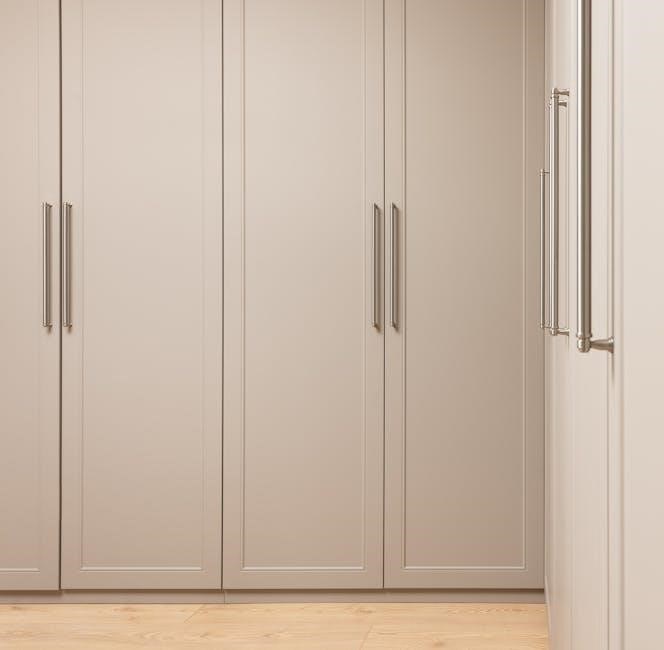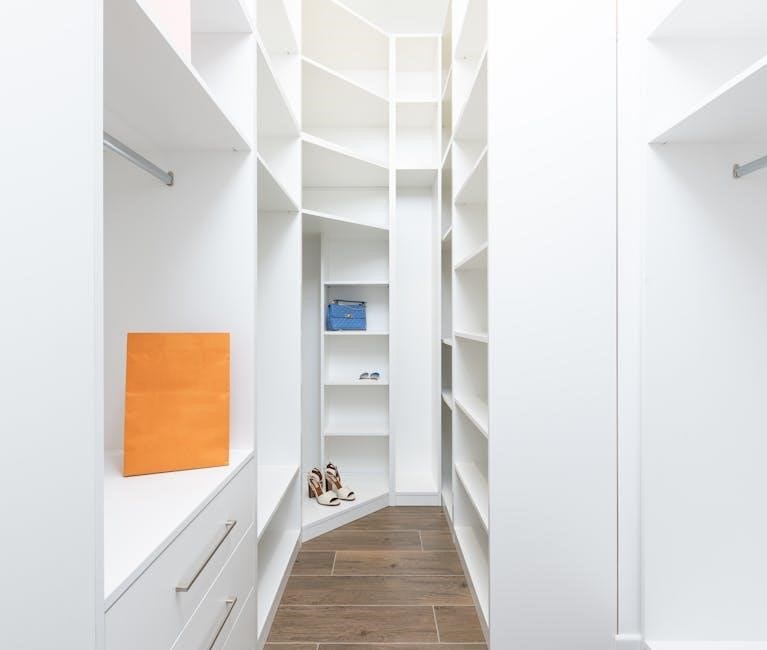A new home walk-through checklist is a comprehensive guide to ensure your property is thoroughly inspected before closing. It covers exterior, interior, and system checks, helping buyers verify all components are in good condition and functioning properly. This essential tool streamlines the final inspection process, ensuring no details are overlooked and providing a clear record for future reference. Use it to document any issues and create a punch list for repairs, giving you peace of mind as you finalize your new home purchase.
Why a Walk-Through Checklist is Essential
A walk-through checklist is a vital tool for ensuring your new home is thoroughly inspected before closing. It helps identify potential issues early, preventing costly repairs down the line. By systematically evaluating every aspect of the property, from exterior features to interior systems, you can confirm that all components are in good condition and functioning as intended. This checklist also provides a clear record of the property’s state, protecting both buyers and sellers. It ensures transparency and accountability, giving you peace of mind as you finalize your new home purchase. A detailed checklist is your first line of defense against future headaches.

Pre-Closing Preparation
Allow several days between inspection and closing to ensure all issues are addressed. Don’t rush; verify repairs and document everything for a smooth transition to homeownership.
Understanding the Importance of a Final Walk-Through
A final walk-through is crucial for verifying that your new home meets agreed-upon standards. It ensures all systems and components are functional and any repairs requested are completed. This step allows buyers to identify and address issues before closing, preventing future headaches. Conducting a thorough inspection with a checklist helps ensure nothing is overlooked, from major systems like HVAC and plumbing to minor details like flooring and fixtures. It’s also an opportunity to confirm that the property is clean and ready for occupancy, providing peace of mind as you finalize your purchase.
What to Expect During the Walk-Through Process
During the walk-through process, buyers conduct a systematic evaluation of their new home, checking all areas and systems for completeness and functionality. This includes inspecting exterior features like driveways and landscaping, as well as interior components such as flooring, walls, and fixtures. The process involves identifying any defects or incomplete work, ensuring all agreed-upon repairs are completed. Buyers should allocate sufficient time for this inspection, avoiding rushed decisions. Documentation of findings is crucial, and any unresolved issues should be addressed in writing with the developer. This step ensures the home is move-in ready and meets the buyer’s expectations.

Exterior Inspection
The exterior inspection covers the foundation, roof, gutters, driveways, and landscaping. Check for cracks in the foundation and ensure the roof is free of damage. Verify gutters are securely attached and functioning properly. Inspect driveways and walkways for cracks and ensure proper leveling. Examine landscaping for completeness and health, making sure all agreed-upon elements are in place. This step ensures the home’s exterior is structurally sound and visually appealing, providing a solid foundation for the rest of the inspection process.
Foundation and Structure
Inspect the foundation for cracks or signs of damage, ensuring it is level and secure. Check the structural integrity of walls, windows, and doors, verifying proper alignment and sealing. Ensure the roof is free of damage, gutters are securely attached, and downspouts function correctly. Look for any signs of water damage or settling issues. Verify that all exterior components are properly installed and aligned. This step ensures the home’s foundation and structure are stable and free from defects, providing a solid base for the rest of the property. Any issues found should be documented for immediate attention.
Roof and Gutters
Examine the roof for damaged, missing, or loose shingles and ensure proper installation. Check for sagging areas, curled edges, or signs of wear. Inspect gutters and downspouts for blockages, ensuring they are securely attached and functioning correctly. Verify that water flows freely through the system without pooling or leakage. Look for rust, dents, or gaps in gutter seams. Ensure all flashing around chimneys, vents, and skylights is sealed and in good condition. Document any damage or issues to address with the builder or seller, ensuring the roof and gutters are ready for weather conditions and long-term durability.
Driveways and Walkways
Inspect driveways and walkways for cracks, uneven surfaces, or damage. Ensure the pavement is level and properly aligned. Check for any discoloration or staining on the surface. Verify that all specified materials and finishes match the agreed-upon design. Look for proper drainage to prevent water pooling. Test the durability of the surface by checking for chips or crumbling edges. Ensure all joints are sealed and even. Document any issues or defects for the builder to address. This inspection ensures the driveways and walkways are safe, functional, and visually appealing for years to come.
Landscaping
Inspect the landscaping to ensure all planted grass, shrubs, and trees are healthy and properly installed. Check for even coverage and proper grading to prevent water pooling. Verify that all outdoor features, such as sod, mulch, and plants, match the agreed-upon design. Look for any signs of damage or poor workmanship. Ensure all hardscaping elements, like patios and retaining walls, are level and securely constructed. Check for proper installation of irrigation systems and confirm they are functioning correctly. Document any defects or incomplete work and ensure all landscaping meets the standards outlined in your contract.

Interior Inspection
The interior inspection ensures all rooms, including walls, ceilings, and floors, are free from damage and defects. Check for proper paint application, secure fixtures, and functional doors. Verify flooring is installed correctly and matches specifications. Inspect windows for proper sealing and ensure all hardware functions smoothly. Ensure bathrooms and kitchens are fully operational, with all appliances and plumbing systems working as intended. Document any issues and create a punch list for necessary repairs, ensuring your new home meets your expectations.
Walls, Windows, and Ceilings
Inspect walls for cracks, uneven surfaces, or paint imperfections. Ensure all windows function properly, with no broken seals or damage to frames. Check ceilings for stains, water marks, or uneven finishes. Verify that all windows open and close smoothly, and their locks operate correctly. Look for proper alignment of walls and ceilings, ensuring no gaps or misalignment. Test for any drafts around windows and confirm that all glass panes are intact. Use a flashlight to spot any imperfections in the paint or surfaces. Document any issues to address them before finalizing the purchase.
Flooring
Check for cracks, uneven surfaces, or damage on all types of flooring, including hardwood, tile, carpet, and laminate. Verify that flooring is properly installed and aligned, with no gaps between planks or tiles. Inspect for scratches, dents, or discoloration, especially in high-traffic areas. Test the stability of the flooring by walking on it to ensure it doesn’t creak excessively. Check transitions between different flooring types for smoothness and proper installation. Ensure that all flooring meets the specifications agreed upon in the purchase contract. Document any imperfections or issues to address them before closing.
Kitchen and Bathrooms
Inspect all kitchen and bathroom fixtures, ensuring they are in excellent condition. Check countertops, sinks, and faucets for leaks or damage. Verify that all appliances, including ovens, dishwashers, and microwaves, are functioning properly and free of scratches or dents. In bathrooms, examine showers, bathtubs, and toilets for proper installation and functionality. Test water pressure and check for any water leaks; Ensure mirrors and lighting are securely installed. Look for any cracks or uneven surfaces in tiles or flooring. Make sure all cabinetry is properly aligned and doors open and close smoothly. Document any defects or issues for the seller to address;
Attic and Basement
Examine the attic for proper insulation, ventilation, and structural integrity. Check for signs of moisture, mold, or pest infestation. Ensure all electrical components, such as wiring and outlets, are securely installed and functioning. In the basement, inspect the foundation walls for cracks or water damage. Verify that the floors are level and free of stains or water marks. Test for proper drainage and ensure sump pumps are operational. Look for any signs of rodent or insect activity. Ensure access points to utilities are clear and functional. Document any issues requiring attention to ensure the spaces are safe and secure for future use.

Systems and Appliances
This section covers essential home systems and appliances, ensuring they function correctly. Check HVAC, plumbing, electrical systems, and all major appliances for proper operation and condition.
Heating, Cooling, and HVAC Systems
Inspect the HVAC system to ensure it operates efficiently; Test the thermostat by adjusting temperatures to confirm heating and cooling functions work correctly. Check for proper airflow through vents and verify that all filters are clean and correctly installed. Ensure there are no unusual noises or leaks from the system. Examine the condenser and evaporator coils for damage or debris. Confirm that all components, including the furnace, air handler, and outdoor unit, are accessible and properly maintained. Document any issues and ensure repairs are addressed before closing. Proper HVAC function is crucial for comfort and energy efficiency in your new home.
Plumbing and Water Systems
Inspect plumbing and water systems to ensure they function properly. Check for leaks under sinks, around toilets, and near appliances. Test water pressure by running multiple faucets simultaneously. Verify proper drainage by checking that water flows smoothly in sinks, showers, and bathtubs. Inspect water heater settings and ensure it is correctly sized for the home. Look for visible damage or corrosion on pipes and fixtures. Test all valves to ensure they open and close fully. Check the irrigation system if applicable. Document any issues, such as low water pressure or leaks, and ensure they are addressed before closing. Proper plumbing is essential for daily convenience and to prevent costly repairs.
Electrical Systems
Inspect electrical systems to ensure they are safe and functioning correctly. Test all outlets, switches, and lighting fixtures to confirm they work properly. Check that GFCI outlets are installed in bathrooms, kitchens, and outdoor areas, and test their functionality. Verify that the electrical panel is properly labeled and that circuit breakers are functioning as intended. Ensure all fixtures, including ceiling fans and recessed lighting, operate smoothly. Test smart home features if applicable. Check for any flickering lights or warm outlets, which could indicate issues. Ensure the electrical system meets the home’s needs and is up to code. Document any malfunctions or concerns for immediate resolution.
Documentation and Next Steps
Document all findings, creating a detailed punch list of repairs or improvements needed. Finalize and share the walk-through report with the builder or seller for resolution before closing.
Creating a Punch List of Repairs
A punch list is a detailed document outlining all repairs or touch-ups needed after the final walk-through. It ensures every issue, from cosmetic flaws to functional problems, is addressed. Include specific descriptions, locations, and photos for clarity. Share the list with the builder or seller to track progress and confirm completion. This step is crucial for holding parties accountable and ensuring your new home meets agreed standards. A thorough punch list helps prevent disputes and guarantees a smooth transition to homeownership.
Finalizing the Walk-Through Report
Finalizing the walk-through report involves reviewing and documenting all findings from the inspection. Ensure the report is comprehensive, including photos and detailed notes on each issue. Once completed, share the report with all relevant parties, such as the builder or seller, to outline necessary repairs. Obtain written confirmation that all agreed-upon fixes will be addressed. Keep a copy for your records and follow up to verify completion. This step ensures transparency and accountability, providing a clear record of the home’s condition at closing.